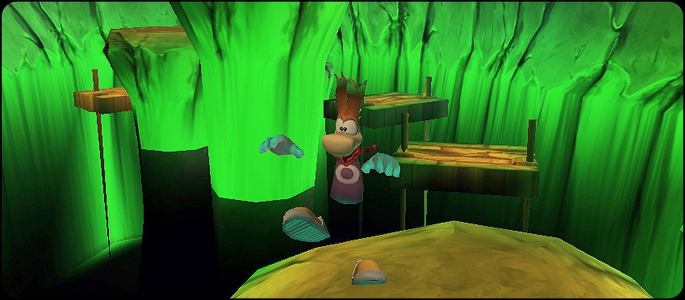The Rayman series has always been noted for its traditionally strong gameplay design. From the original 2D Rayman, to the classic 3D platformer Rayman 2, to the return to its roots with Rayman Origins, the series has always stood out for its notable platforming and difficulty. Rayman 3, though, experimented with some different elements that didn’t work out as well as they could have for the game. A number of changes were made to the Rayman formula that differed far too much from the series’ approach to the genre and resulted in a platforming title that ended up being a solid game, but not quite as polished as other installments.
Rayman 3‘s story is about an evil black lum who has turned good red lums into Hoodlums, the game’s enemies. In what may have eventually started a Rayman tradition, this occurred while Rayman and Globox were sleeping. After the two awaken and a couple of events unfold, they embark on a mission to defeat the Hoodlums and save Globox, who has eaten one of the black lums. When the story begins, Rayman fans will notice right away that the game has full voice acting. The voice acting is okay, but sounds very out of place in a game that’s part of a series with at least two installments that had their own unique approaches to language and character voices. Some characters, like Murphy and occasionally Globox, sound inconsistent with what gamers would imagine that their voices sound like.
The changes to the formula don’t stop at voice acting, though. The traditional platformer world map present in previous 3D installment Rayman 2 — and later present again in Origins — has been replaced by a linear level-by-level progression system that doesn’t allow gamers to go back and collect anything that they might have missed. Also, the game has placed an unusual emphasis on scoring: everything Rayman does in Rayman 3 involves points. If Rayman collects jewels/gems or defeats enemies, he gains points. However, if he gets hit by enemies or dies while on a disco trip, he loses points. Points unlock bonus mini-game levels in the Arcade section of the pause menu (gamers who are looking out for jewels and Teensies shouldn’t have any problems accumulating enough points to unlock them, though). Rayman is constantly gaining and losing points in the game for various actions, and it almost feels like Rayman 3 has an RPG element to it that never materializes. The presence of scoring also feels strange in a game that’s part of a series that has never really been about scoring points.
The changes made to Rayman 3‘s formula don’t hinder the game per se, as the title is an overall solid platformer that is very reminiscent of titles in the genre from circa the late 1990s to the early 2000s (powers, collecting jewels, etc. — very indicative that Rayman 3 was released in 2003). The platforming itself is fine. The combat’s only issues are a limited range for Rayman’s punches and attacks and an emphasis on the targeting reticule being active for attacks to land, both of which likely exist because the game was released in 2003. Some of Rayman 3‘s gameplay sequences, though, are repetitive and sometimes frustrating exercises in trial and error. Bosses especially have players repeating the same strategies over and over again. Also, when Rayman dies, he restarts at a checkpoint, which is often too far back from where players would expect it to be. The sequences in which these circumstances occur weigh down players’ enjoyment of an otherwise very solid platformer.
One set of sequences in particular negatively impact the game: disco trips, which take place at the end of every world’s series of levels. Rayman rides a board on broken-up paths to reach the next world, jumping between them to advance. However, when Rayman jumps, the analog stick must be moved just enough in the appropriate direction — otherwise, Rayman falls to his death and restarts at a checkpoint that can be a distance from where players encountered their trouble spot. Guessing the right amount of direction to tilt in for a particular jump can take numerous attempts. Rayman can also be moved closer to the left or right edges of the paths by the player, which affects the amount of direction required to get him to land on the next path upon his jump and makes guessing the correct amount of direction to tilt in more difficult. Disco trips could have been an interesting and fun addition to Rayman 3, though, with a bit more refinement in their execution and with the addition of more frequent checkpoints.
Graphically, the visuals seem to have been brightened up beautifully since the release of the original. The game runs fine at 60 frames per second and no discernible technical problems were seen or heard, although it must be noted that my PS3 did freeze once and once had a strange PSN sign-in error while playing the game. Otherwise, no other issues were encountered. In terms of bonuses for the HD upgrade, Rayman 3 HD includes artwork from Rayman Origins and online leaderboards for players to check their scores against players from all over the world. Both are nice additions to the game and Origins fans will be especially appreciative of the artwork included in the game.
Rayman 3 HD is an HD remaster that fans of the original may love, but may be a bit more difficult to access for Rayman fans who had never played the game during its original release period. The changes from the series’ traditions and the usual gameplay design may put off some, but fans of the Super Mario 64 era of platformers should very much like Rayman 3‘s gameplay experience. Ubisoft did a solid job of handling the game technically and brightening up the visuals for the high-definition era as well. Rayman 3 HD is a solid PSN port/remaster of a solid PS2 platformer that, for newcomers, may show signs that it was released in a previous generation, but will prove to be an enjoyable experience for those who liked the original release.
PlayStation LifeStyle’s Final Score
+ Good HD remastering, leaderboards and Origins artwork are nice touches – Too few checkpoints, repetitive sections, occasionally frustrating trial and error |
 |






